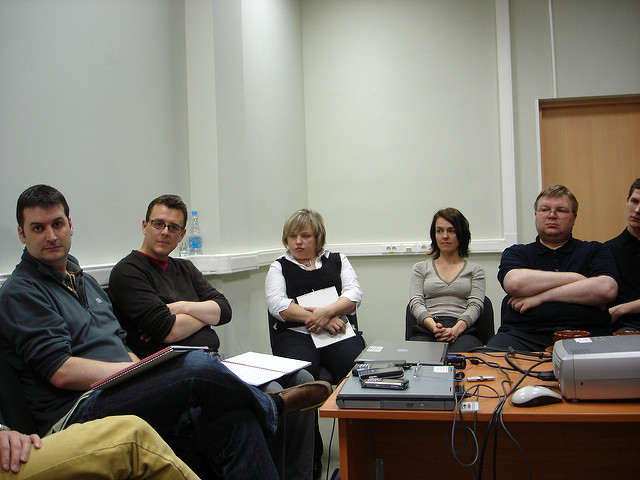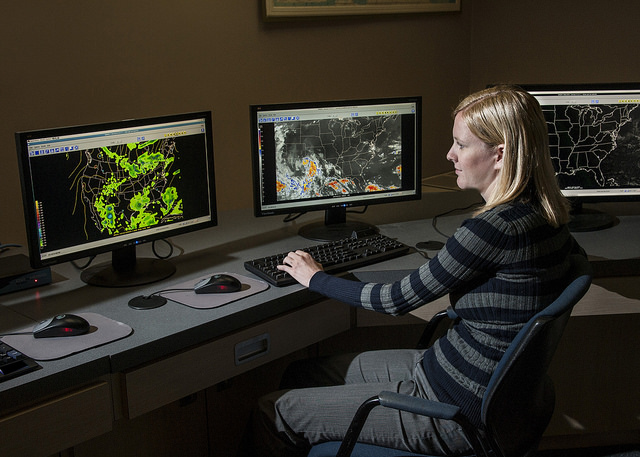1.1: Communication: History and Forms
Learning Objectives
- Define communication.
- Discuss the history of communication from ancient to modern times.
- List the five forms of communication.
- Distinguish among the five forms of communication.
- Review the various career options for students who study communication.
Since the systematic study of communication began in colleges and universities a little over one hundred years ago, there have been more than 126 published definitions of communication (Dance & Larson, 1976, 23). For our purposes, we will define communication as the process of generating meaning by sending and receiving verbal and nonverbal symbols and signs that are influenced by multiple contexts. As even this basic definition reveals, a successful communication act involves careful crafting and monitoring of our messages on multiple levels.
Let us start with a brief discussion of the history of the field and of the types of communication on which we’ll be focusing in this textbook and course.
A Brief History of Communication
All animals communicate and it is possible, for instance, to teach a gorilla to use signs to designate words like food and baby. However, humans’ ability to use symbols to communicate about things outside their immediate temporal and spatial reality is unique (Dance & Larson, 23).
How did this ability evolve? Humans’ first words may have been strictly onomatopoetic (= words that sound like the objects/phenomena to which they refer, such as boing, drip, gurgle, swoosh, and whack). A prehistoric human being might have used gurgle to alert others to the presence of water or swoosh and whack to recount what happened on a hunt. This primitive ability to communicate provided an evolutionary advantage. Humans who could talk were able to cooperate, share information, make better tools, impress mates, or warn others of danger, which led them to have more offspring who were also more predisposed to communicate (Poe, 2011, 27). This eventually led to the development of a “Talking Culture” during the “Talking Era” — a 150,000-year period of human existence ranging from 180,000 BCE to 3500 BCE (Poe, 2011).
The beginning of the “Manuscript Era” (around 3500 BCE) marked the turn from oral to written culture and paralleled a shift to a more settled, agrarian way of life (Poe, 2011, 27). As hunter-gatherers settled into small villages and began to plan ahead for how to plant, store, protect, and trade or sell their food, they needed accounting systems to keep track of their materials and record transactions. While such transactions were initially tracked with actual objects that symbolized an amount — for example, five pebbles represented five measures of grain — symbols, likely carved into clay, later served as the primary method of record keeping. In this case, five dots might equal five measures of grain.
During this period, villages also developed class systems as more successful farmers prospered and took leadership positions. Religion also became more complex and a new class of spiritual leaders emerged. Soon, armies were needed to protect the stockpiled resources from others who might want to steal it. The emergence of elite classes and the rise of armies required records and bookkeeping which furthered the spread of written symbols and required them to become more complex. Still, literacy (the ability to read and write) didn’t spread far beyond the most privileged in society. In fact, it wasn’t until the 1800s that widespread literacy existed in the world.
The end of the “Manuscript Era” marked a shift toward a rapid increase in communication technologies. The “Print Era” extended from 1450 to 1850 and was marked by the invention of the printing press and the ability to mass-produce written texts. This 400-year period gave way to the “Audiovisual Era,” which only lasted 140 years, from 1850 to 1990, and was marked by the invention of radio, telegraph, telephone, and television. Our current period, the “Internet Era,” has only lasted from 1990 until the present. This period has featured the most rapid dispersion of a new method of communication, as the spread of the Internet and the expansion of digital and personal media signaled the beginning of the digital age.

How about our understanding of communication? How did that evolve, in relation to the evolution of communication media, from speaking to digital technology?
Ancient Greek philosophers and scholars defined rhetoric as the art of speaking well and persuasively. Today, we hear the word rhetoric used in negative ways — politicians may dismiss opponents’ statements as “pure rhetoric” — but the primary meaning of the word is unrelated to making misleading, false, or unethical statements. Rhetorical strategies are not in themselves substantial or not, ethical or not. It all depends on the speaker’s purpose and use of those strategies.
The study of rhetoric initially focused on public communication, primarily oratory, used in discussions or debates regarding laws and policy, speeches delivered in courts, and speeches intended to praise or blame a public personality. The connections among rhetoric, policy making, and legal proceedings show that communication and citizenship have been connected since the study of communication began. Throughout this book, we will continue to make connections between communication, ethics, and civic engagement.
Throughout the Antiquity, the Middle Ages, and the Age of Enlightenment, oratory and clear written communication remained in focus primarily in connection with public speaking, civic engagement, and academic development. However, distinct communication studies departments began to be established very late — communication studies as a distinct academic discipline with departments at universities and colleges has only existed for a little over one hundred years (Keith, 2008, p. 240). The formalization of speech departments led to an expanded view of the role of communication. Even though Aristotle and other ancient rhetoricians and philosophers had theorized the connection between rhetoric and citizenship, the role of the communicator became the focus, instead of solely focusing on the message. James A. Winans, one of the first modern speech teachers and an advocate for teaching communication in higher education, said there were “two motives for learning to speak. Increasing one’s chance to succeed and increasing one’s power to serve” (as cited in Keith, 2008, p. 253). Later, as social psychology began to expand in academic institutions, speech communication scholars saw places for connection to further expand definitions of communication to include social and psychological contexts.
What do scholars in communication departments study today? Let’s use former U.S. President Obama as a case study. Fairly traditional rhetoricians might study his public speeches in comparison with other presidential rhetoric. Others may study debates between presidential candidates, dissecting the rhetorical strategies used, for example, by Barack Obama and his opponent, Republican presidential candidate Mitt Romney. Expanding from messages to channels of communication, scholars may study how different media outlets cover presidential politics. At an interpersonal level, scholars may study what sorts of conflicts emerge within families between liberal and conservative family members. At a cultural level, communication scholars could study how the election of an African American president may influence our perception of race and of racial relations.
How about our focus in this course? We will touch on such larger socio-cultural issues insofar as they allow us to become better communicators in specific professional situations. As you will see, a broader understanding of various socio-cultural phenomena may substantially improve our communication skills in multiple ways — from allowing us to use a positive and motivating tone even in the most challenging professional situations to enhancing our intercultural communication and social media expertise.
To further answer the last question, let us now move to a brief discussion of the five main forms of communication, as they are typically categorized in communication studies, so we can understand to what extent and why we will focus more on some than on others.
Forms of Communication
Forms of communication vary in terms of participants, channels used, and contexts. The five main forms of communication are intrapersonal, interpersonal, group, public, and mass communication. Let us quickly define them and discuss relevant similarities and differences between them, especially in terms of level of intentionality, goals, and contexts.
1. Intrapersonal communication is communication with oneself using internal vocalization or reflective thinking. Like other forms of communication, intrapersonal communication is triggered by some internal or external stimulus. We may, for example, communicate with ourselves about what we want to eat due to the internal stimulus of hunger, or we may react intrapersonally to events we witness. Intrapersonal communication takes place only inside our heads — others do not perceive it — yet it has multiple significant social functions:

- achieving or maintaining social adjustment (Dance & Larson, 1972, Part II) — e.g. using self-talk (internal vocalization) to calm ourselves or to remind ourselves to smile at key moments during a presentation.
- building and maintaining our self-concept — e.g. internalizing certain qualities as part of our self-concept because we noticed that we tend to be perceived that way (this could be beneficial or not — we could, for instance, become more confident this way or bring ourselves down…).
- processing emotions, thinking through something, or rehearsing what we plan to say or do in the future — e.g. processing feelings of anger in order to avoid expressing them out loud, or planning what to say as we are waiting for an important meeting to start.
As with the other forms of communication, competent intrapersonal communication helps facilitate social interaction and can enhance our well-being. Conversely, the breakdown in the ability of a person to intrapersonally communicate is associated with mental illness (Dance & Larson, 1972, p. 67).
Sometimes we intrapersonally communicate for the fun of it such as when we think of something funny. Such communication is typically unplanned and doesn’t include a clearly defined goal (Dance & Larson, 1972, 99). We can, however, engage in more intentional intrapersonal communication. In fact, deliberate self-reflection can help us become more competent communicators as we become more mindful of our own behaviors. In your everyday experiences, your internal voice may praise or scold you based on a thought or action. In our course, you are encouraged to use intrapersonal communication to do the following:
- monitor and assess your communication acts based on the way you would like to be treated by others in similar situations;
- shift strategy if this monitoring and assessment work tells you that you may have taken an ineffective approach; and
- reflect on any communication act in this way after the fact, so you can learn from the experience.
The main distinction between intrapersonal communication and the other four types is that it is not created with the intention that another person will perceive it. For all the other types, the fact that the communicator anticipates consumption of their message is very important.
2. Interpersonal communication is communication between people whose lives influence one another. Interpersonal communication builds, maintains, and ends our relationships, and we spend more time engaged in interpersonal communication than the other forms of communication. Accordingly, it should come as no surprise that this is the form of communication we will focus on the most in this textbook and course. Interpersonal communication occurs in various contexts and is addressed in subfields of study within communication studies such as intercultural communication, organizational communication, social media communication, health communication, etc.
Since this form of communication plays a major role in building and maintaining personal relationships and is the most common form of communication, instances of miscommunication and communication conflict most frequently occur here. Couples, family members, and bosses and employees all have to engage in complex interpersonal communication, and it doesn’t always go well. A competent interpersonal communicator may need conflict management skills and listening skills, among others, to maintain positive relationships.

3. Group communication is communication among three or more people interacting to achieve a shared goal. You have likely worked in groups in high school and college, and if you’re like most students, you didn’t always enjoy it. Although sometimes frustrating, group work in an academic setting provides useful experience and critical preparation for group work in professional settings.
Group communication is more intentional and formal than interpersonal communication because group members are typically placed within a group (they do not make that choice themselves and might not know each other well) and because group communication is often task-focused (members of the group work together for an explicit purpose or goal that affects each member of the group).
Working with several other communicators usually leads to more complicated interactions. Some challenges of group communication relate to task-oriented interactions (e.g., deciding who will complete each part of a larger project) but many stem from interpersonal conflict or misunderstandings among group members. Since group members also communicate with and relate to each other interpersonally and may have pre-existing relationships or develop them during the course of group interaction, elements of interpersonal communication also occur within group communication.
4. Public communication is a sender-focused form of communication in which one person is typically responsible for conveying information to an audience. Public speaking is something that many people fear, or at least don’t enjoy. But, just like group communication, public speaking is an important part of our academic, professional, and civic lives. When compared to interpersonal and group communication, public communication is the most consistently intentional, formal, and goal-oriented form of communication discussed so far.
Although public speakers don’t necessarily develop individual relationships with audience members, they are face-to-face with them and can receive verbal and nonverbal feedback. In the part of this textbook and course dedicated to presentations and interviews, you will learn some strategies for managing potential speaking anxiety. Public speaking is an important aspect of professional communication because as you will engage in it in multiple contexts at work — from routine meetings to more formal presentations in front of colleagues, upper-management employees, shareholders, clients, etc.

5. Mass communication is a form of public communication that is transmitted to many people through print or electronic media. While print media such as newspapers and magazines continue to be an important channel for mass communication, television, websites, blogs, and social media are dominant mass communication channels today. Additionally, radio, podcasts, and books are other examples of mass media. The technology required to send mass communication messages distinguishes it from the other forms of communication. A certain amount of intentionality goes into transmitting a mass communication message since it usually requires one or more extra steps to convey the message. This may involve pressing “Enter” to send a Facebook message or involve an entire crew of camera people, sound engineers, and production assistants to produce a television show. Even though the messages must be intentionally transmitted through technology, the intentionality and goals of the person actually creating the message, such as the writer, television host, or talk show guest, vary greatly. A Prime Minister’s various speeches are mass communication messages that are very formal, goal oriented, and intentional, but a Prime Minister’s verbal gaffe during a news interview is not.
Even though creating the illusion of a personal connection is often a goal of those who create mass communication messages, in some contexts there is no immediate verbal and nonverbal feedback loop in mass communication. For instance, readers could write letters to the editor of a newspaper or send e-mails to a television or radio broadcaster in response to a story where the immediate feedback available in face-to-face interactions is not present. However, with new media technologies such as Twitter, blogs, and Facebook, feedback is becoming more immediate. Individuals can now tweet directly “at” (@) someone and use hashtags (#) to direct feedback to mass communication sources. Many radio and television hosts and news organizations specifically invite feedback from viewers/listeners via social media and may even share the feedback on the air.
While there is potential for unethical communication with all forms, the potential consequences of unethical mass communication can be massive. Communication scholars who focus on mass communication and media often take a critical approach in order to examine how media shapes our culture and who is included and excluded in various mediated messages.
Spotlight: “Getting Real”
What Can You Do with a Diploma or Degree in Communication Studies?
You’re hopefully already beginning to see that communication studies is a diverse and vibrant field of study in itself, as well as a component of great importance for a wide variety of technical and business fields. Communication courses offered in various graduate certificate programs at Fanshawe may focus on aspects of communication such as public relations, rhetoric, interpersonal communication, electronic media production, corporate communication, etc.
This textbook takes a broader approach to enhance your communication competence and skills in interpersonal communication, intercultural communication, group communication, employment communication, and public speaking, among others.
Exercises
The main career areas that communication majors go into are business, public relations/advertising, media, nonprofit, government/law, and education. Within each of these areas there are multiple career paths, potential employers, and useful strategies for success:
- Business. Sales, customer service, management, real estate, human resources, training and development.
- Public relations/advertising. Public relations, advertising/marketing, public opinion research, development, event coordination.
- Media. Editing, copywriting, publishing, producing, directing, media sales, broadcasting.
- Nonprofit. Administration, grant writing, fund-raising, public relations, volunteer coordination.
- Government/law. City or town management, community affairs, lobbying, conflict negotiation/mediation.
- Education. High school speech teacher, forensics/debate coach, administration and student support services, graduate school to further communication study.
- In which of the areas listed above are you most interested in studying in school or pursuing as a career? Why?
- In what aspect(s) of communication studies does your graduate certificate program specialize? What concentrations/courses are offered?
- Whether or not you plan to pursue a career as a communication expert, how do you think you could use what you have learned and will learn in this class to “sell” yourself on the job market, or to get promoted faster at work?
Source: What Can I Do with This Major? “Communication Studies,” accessed May 18, 2012, http://whatcanidowiththismajor.com/major/communication-studies.
Key Takeaways
- Communication is a broad field that draws from many academic disciplines. This interdisciplinary perspective provides useful training and experience for students that can translate into many career fields.
- Communication is the process of generating meaning by sending and receiving symbolic cues that are influenced by multiple contexts.
- Ancient Greeks like Aristotle and Plato started a rich tradition of the study of rhetoric in the Western world more than two thousand years ago. Communication did not become a distinct field of study with academic departments until the 1900s, but it is now a thriving discipline with many subfields of study.
- There are five forms of communication: intrapersonal, interpersonal, group, public, and mass communication.
- Intrapersonal communication is with oneself and occurs only inside our heads.
- Interpersonal communication is between people, typically pairs, whose lives mutually influence one another.
- Group communication is among three or more people to achieve a shared goal.
- Public communication is sender-focused and typically occurs when one person conveys information to an audience.
- Mass communication is when messages are sent to large audiences using print or electronic media.
Exercises
- Come up with your own definition of communication. How does it differ from the definition in the book? Why did you choose to define communication the way you did?
- Over the course of a day, keep track of the forms of communication that you use. Make a pie chart of how much time you think you spend, on an average day, engaging in each form of communication (intrapersonal, interpersonal, group, public, and mass).
References
Dance, F. E. X., & Larson, C. E. (1976). The functions of human communication: a theoretical approach. Holt, Rinehart and Winston.
Keith, W. (2008). On the Origins of Speech as a Discipline: James A. Winans and Public Speaking as Practical Democracy. Rhetoric Society Quarterly, 38(3), 239–258. DOI:10.1080/02773940801958446
Poe, M. T. (2011). A History of Communications: Media and Society from the Evolution of Speech to the Internet. Cambridge University Press.


